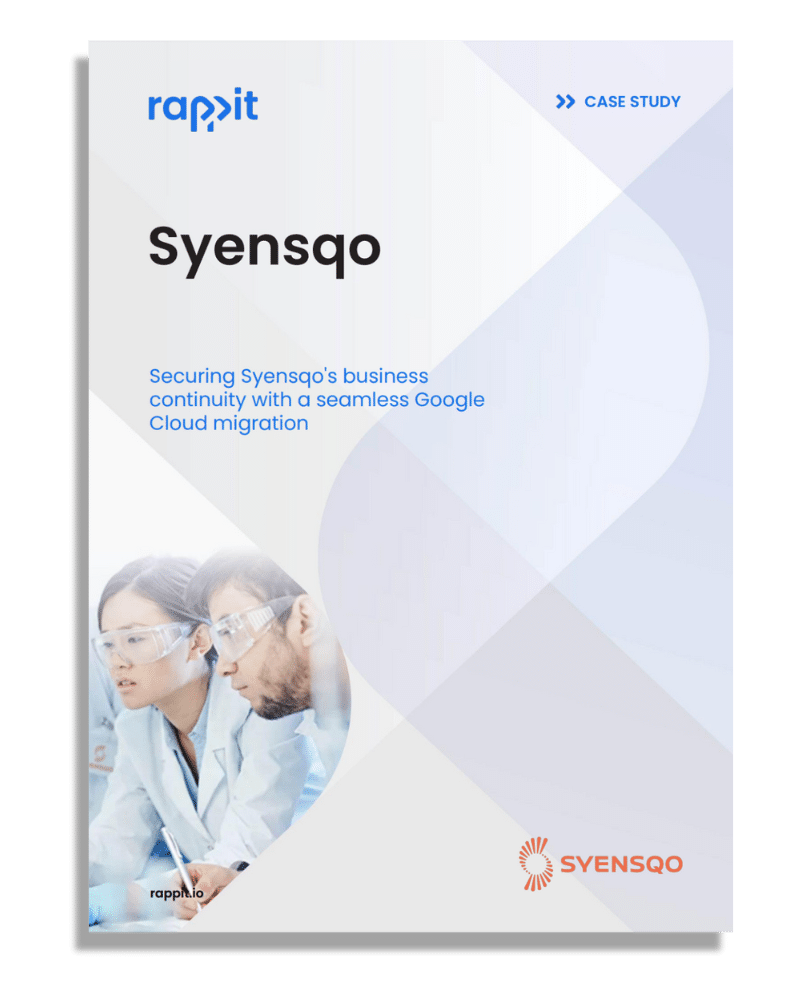Securing Syensqo’s business continuity with a seamless Google Cloud migration
Following its spin-off from Solvay, Syensqo, a global leader in advanced materials with 13,000 employees across 30 countries, faced a critical challenge. As part of its separation from Solvay in December 2023, Syensqo had an extremely tight deadline to migrate hundreds of its business-critical applications and associated data from Solvay’s existing Google Cloud Platform (GCP) environment to a new, independently managed GCP infrastructure. Rappit was chosen as their global partner to strategically set up, migrate, and manage this complex, time-, and business-critical transition.

Their challenges
Syensqo, a global leader in advanced materials, faced the immense task of migrating 100+ critical applications and data from Solvay’s GCP environment to a new, independent GCP infrastructure within an extremely tight deadline following their spin-off from Solvay.
- 100+ applications: The necessity of migrating hundreds of critical applications and their associated data from Solvay’s GCP environment to a new, independent GCP infrastructure, guaranteeing proper data
segregation and adhering to compliance and monitoring frameworks. - Business-critical: Migration of business-critical systems deeply integrated with SAP ERP, Tableau, Dataiku, and Ariba demanded meticulous planning to prevent service disruption or data loss.
- High risk of service disruption or data loss during the migration process, which could impact reporting, analytics, procurement, and operational decision-making.
This wasn’t just a technical migration but a business-critical operation. The applications were deeply integrated with vital enterprise systems. Any disruption could impact critical analytics, daily operational decision-making, and more. Syensqo needed a partner who could guarantee a seamless transition.

Our solutions
Rappit proposed a phased migration, starting with a robust GCP landing zone, employing a “Clone and Clean” methodology for data segregation, and automating infrastructure setup using Infrastructure as Code (IaC). Each application migration followed a detailed cut-over plan and hypercare period.
- Rappit proposed a phased migration solution. The initial phase focused on establishing a robust Google Cloud landing zone – leveraging GCP’s core networking principles using Shared
VPC, security through IAM, organizational policies, and governance controls aligned with best practices, policies, and principles. - Employed “Clone and Clean” methodology, which involved an exact replication of the applications in their current state, followed by a data cleaning process.
- Automated infrastructure setup using Infrastructure as Code (IaC) scripts to ensure consistent and repeatable environments while adhering to organizational policies and security compliance.
- Migration of the application code and data, including the splitting the data to isolate Syensqo’s information and performing the necessary cleanup. Followed by a detailed cutover plan and a hypercare period to ensure a smooth transition.
Results
- Established a robust landing zone at the outset, and implemented a security-first approach that automatically ensured over 80% adherence to critical CIS benchmarks for cloud security, a
substantial improvement over manual provisioning methods. - Seamless migration & 100% business continuity: the structured migration strategy ensured that all 100+ business-critical applications transitioned to the new GCP environment within the one-year timeline, achieving zero disruption to core business operations and no unplanned downtime throughout the migration process.
- Substantial reduction in operational costs by strategically leveraging Google Cloud’s inherent scalability and Rappit’s cost-optimized migration strategy.
- Executing a risk-free migration within the expected deadline while reducing costs, improving performance, and ensuring business continuity.

Want to check it out later?
Download the full PDF case study to explore our work in detail. Perfect for a closer look at your own pace.
Technologies used
- Google Cloud products, Compute Engine, Google Kubernetes Engine (GKE), Cloud Run, Virtual Private Cloud (VPC), Cloud Load Balancing, Cloud DNS, Cloud Interconnect, Cloud Storage, BigQuery, Cloud SQL, Cloud Functions, Artifact Registry, Cloud Build, Pub/Sub, and more.
- Open-source technologies Java, Angular